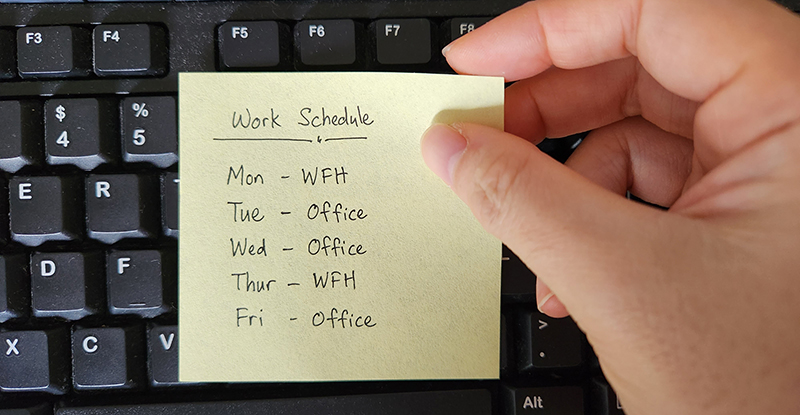
In our podcast episode, Carolyn Stern, professor with the School of Business at Capilano University, chats with Leah Giesbrecht, communications specialist at CPABC, about how we can use emotional intelligence to bring more balance to our work days. Part of our Coffee Chats with CPABC podcast series.
Expanding on our popular Women’s Leadership Series, our new Women's Leadership Mini-Series from October 24 - December 5, 2023 will cover new topics designed specifically for women in the accounting profession. All sessions will be held as live webinars. Learn more and register to save your spot!
How many times have you sat at your desk eating lunch while still working? Have you ever felt guilty about taking your break? If you’ve done these things you’re not alone – your team is likely in a similar situation. In fact, studies show that employees are working longer hours than usual, especially during the pandemic.
The pandemic has definitely changed the way we work, making it more difficult to redefine the boundaries between your professional and personal lives. In fact, employee stress levels have risen significantly. Maintaining a culture of work-life balance has become a greater challenge, especially when boundaries are blurred and employees are working more hours.
When work-life balance fails
Teams are failing to prioritize work-life balance as they struggle to navigate through this new way of working, which has led to a lack of productivity, creativity, motivation, and more. With 50% of employers failing to support their employees’ physical well-being, work-life balance will continue to fall.
When leaders fail to instill work-life balance, the emotional, physical, and mental health of the team crumbles. Research has shown that employees who work more than 55 hours per week are at a higher risk of a heart attack and stroke. The end result: your team is feeling stressed more than ever.
This stress is also snowballing into bigger issues, such as employee absenteeism. Think about it – if your team is feeling stressed, chances are if they aren’t physically absent, they can still be mentally absent. Absenteeism can affect productivity, finances, and workplace morale, which directly impacts the bottom line. Beyond the financial impact, with 30% of your team not feeling motivated, those individuals are failing to progress which inhibits growth potential at the person level and in the organization as a whole.
So if the repercussions of poor work-life balance are severe, then why don’t we prioritize it better? Although every team is different, there are some universal emotional intelligence tactics you can bring into your team to mitigate some of the work-life balance concerns.
Balance it out with emotional intelligence
A key component in effectively managing your team’s work-life balance is helping them tune into their emotional intelligence (EQ). As a leader, it begins with you listening to your team members’ emotions, to ensure they feel acknowledged and heard.
Listed below are some crucial EQ competencies that will assist your team in finding their work-life balance.
Self-awareness
Self-awareness is all about understanding yourself, from your needs to your emotions. Once your team becomes in tune with themselves and can understand what they need, they will be able to set boundaries. Being self-aware can also assist your team in recognizing when work-life balance is falling apart. Acknowledging when work-life balance needs to be prioritized is one of the first steps to improvement.
Self-actualization
Self-actualization is the drive to continually improve yourself through engaging in activities and objectives that lead to a fulfilling and enjoyable lifestyle. Individuals on the path to self-actualization live by their values; they know and are continuously on the lookout for activities that give their life meaning and purpose.
Knowing what fulfills your team will help support you in creating more work-life balance for them. Encouraging your team to allocate time for these activities in their personal lives will ultimately contribute to their happiness and productivity at work.
Assertiveness
Being assertive is associated with communicating your emotions, beliefs, and opinions openly, in a non-offensive manner. Assertiveness assists in standing your ground when it comes to work-life balance.
Leaders need to stimulate conversation around communicating boundaries within the team, and set guidelines for when the line is crossed. If boundaries have been overstepped, assertiveness will support your team in communicating that to leadership, so that they are aware of the boundaries and won’t repeat the same mistake.
Improve your work-life balance
Now that you are aware of which EQ competencies will assist your team the most in managing their work-life balance, try these two strategies to enhance your organization’s work-life balance culture!
Unplug and unwind
It is easy to become accustomed to the 24/7 work culture, especially in a digital world. You may tell your team members that you’re only an email away, but you need to set limits so that you’re not attached to your job all day.
The same digital limits are important to encourage throughout the entire organization. For example, instead of sending your email after the team has logged off for the day, try and save it for the morning to allow employees to unplug and unwind for the day.
Some tips to instill in your team are below:
- Close out of work email and other work-related communications platforms once your workday has ended.
- Set notifications to turn off after you clock out.
- Inform others you’ve decided to take the actions above, so they are aware of the appropriate response times.
Encourage setting boundaries on workload
While it’s great to have a team that is always accepting new opportunities, it’s even more crucial to know their workload limits so that you can effectively distribute work.
Communicate to your team that they don’t have to say ‘yes’ to every opportunity you give them. Encourage your team to set this boundary by instead of saying “yes,” say “yes and….” For instance, let’s say your employee has a report due tomorrow, but you ask if they’re able to help you prepare for an upcoming meeting.
The employee is aware that if they take this on, it will impede on the time they have to work on the report due tomorrow. Instead of immediately saying “yes,” create a safe space where the employee can inform you of their workload by saying, “Yes, I could help you prepare for the upcoming meeting, and something that is on my plate is the report that is due tomorrow. If I help you out, this will affect my schedule to work on the report, could I get an extension on the report?”
The balancing act of work-life balance
Work-life balance is crucial to maintaining productivity, positive workplace morale, and a healthy bottom line in the organization. In return, your team’s stress levels will lessen, helping to mitigate the costs of absenteeism. By tuning into your emotional intelligence, you will be able to better manage your team’s work-life balance, and instill a culture of wellbeing and balance that encourages healthy boundary setting.
Carolyn Stern is an expert on the subject of emotional intelligence. She is a professor with the School of Business at Capilano University, where she pioneered the integration of emotional intelligence into Capilano’s curriculum. Since launching her company EI Experience in 2017, Carolyn has helped more than 10,000 business leaders leverage their emotional intelligence skills to connect with their diverse workforce and develop high-performing teams.



